LECTURE 2. PHONEMES AND THEIR VARIANTS (ALLOPHONES) Points
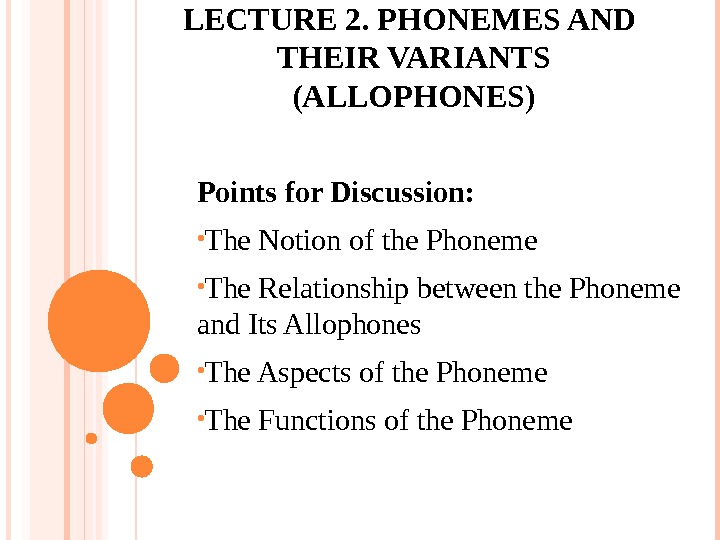
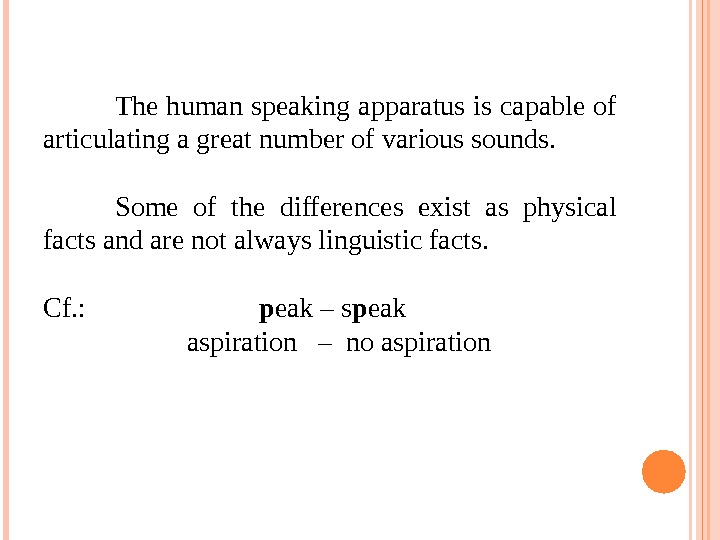
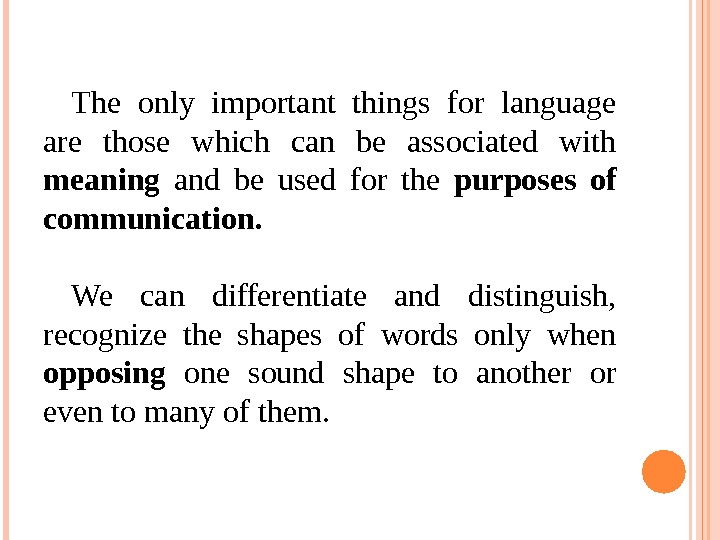

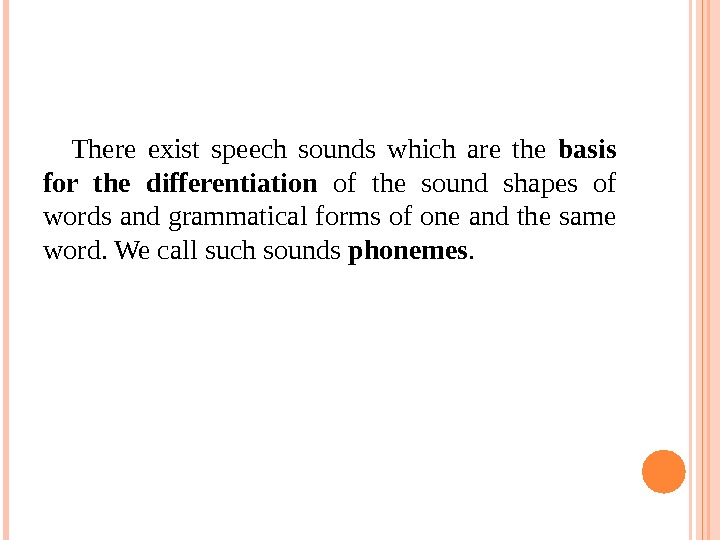
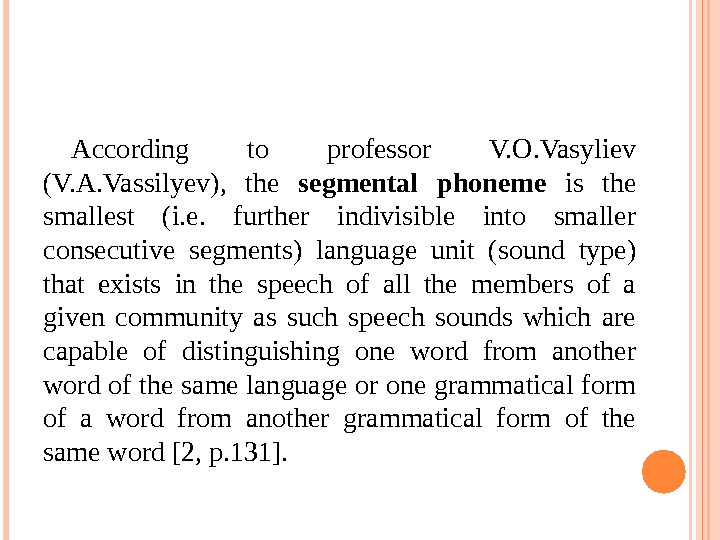
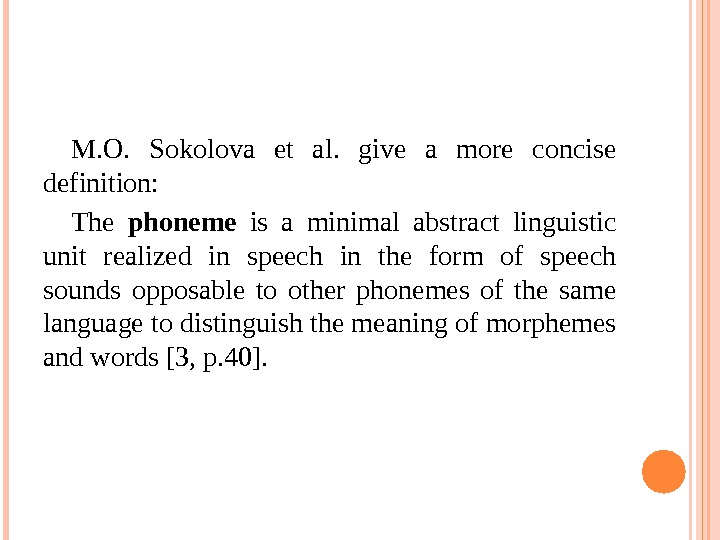
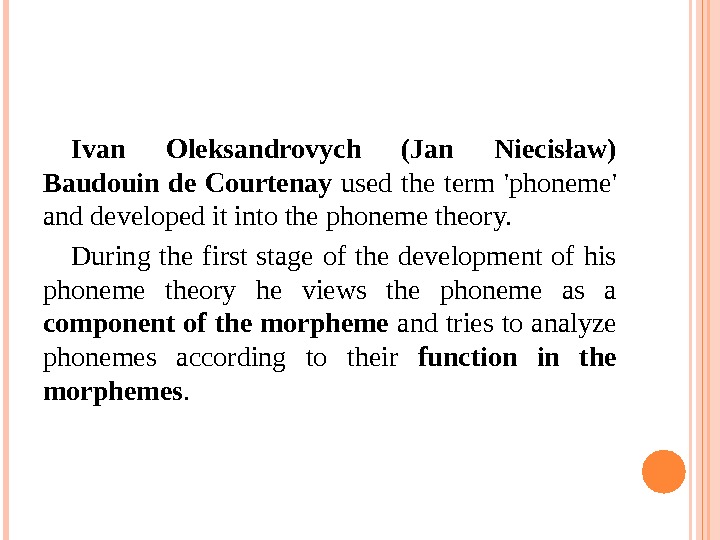
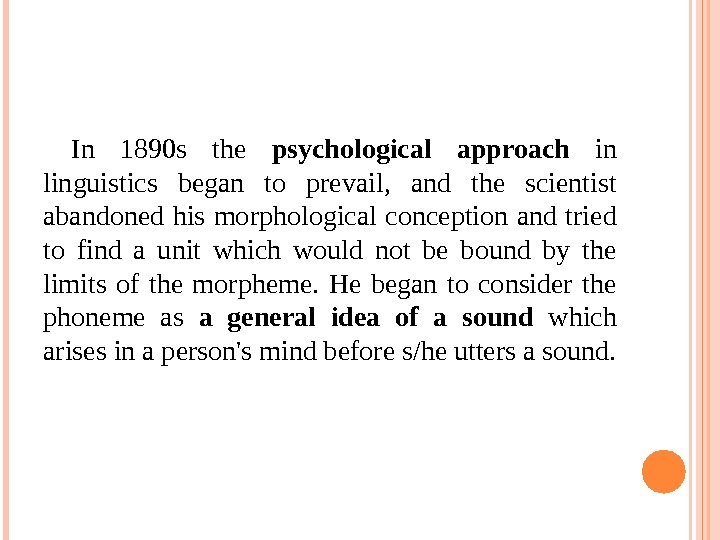
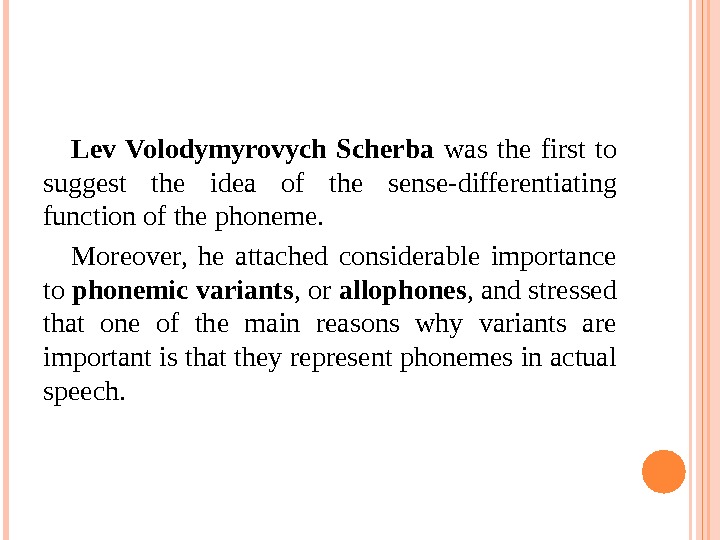

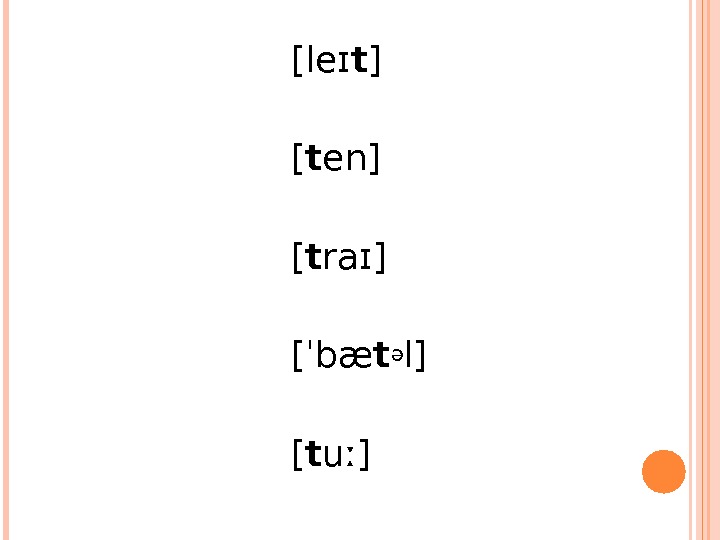

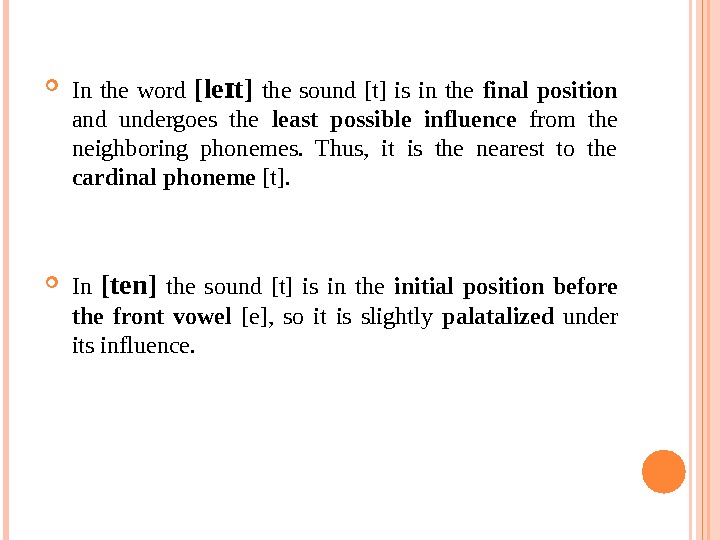
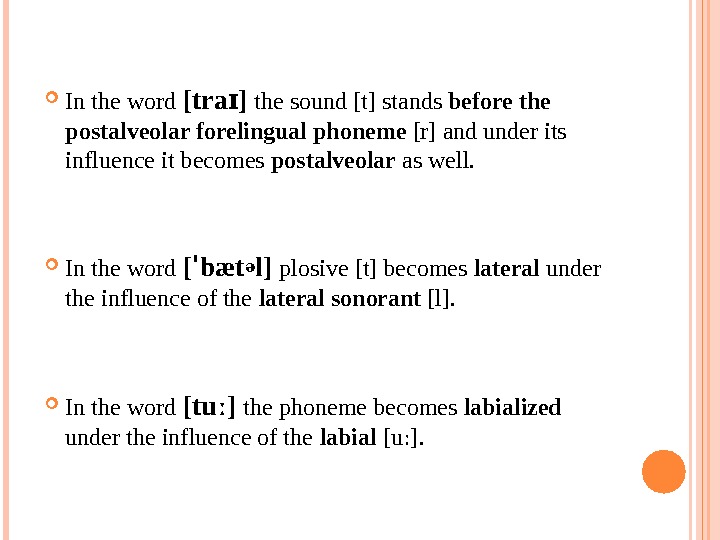
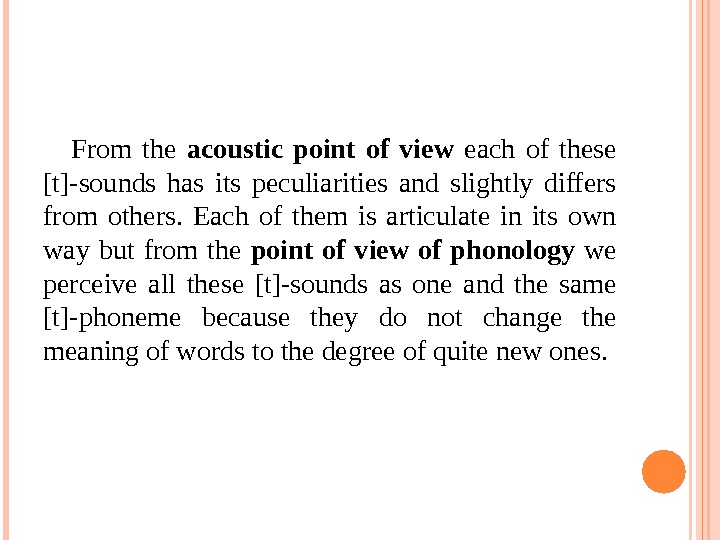
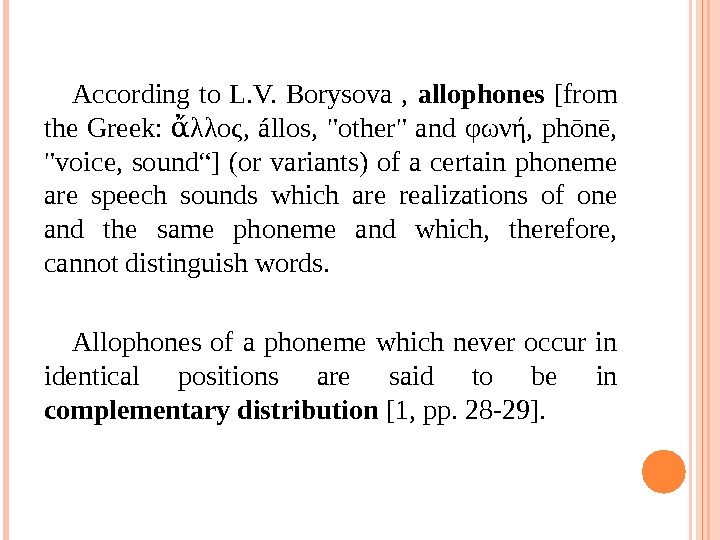
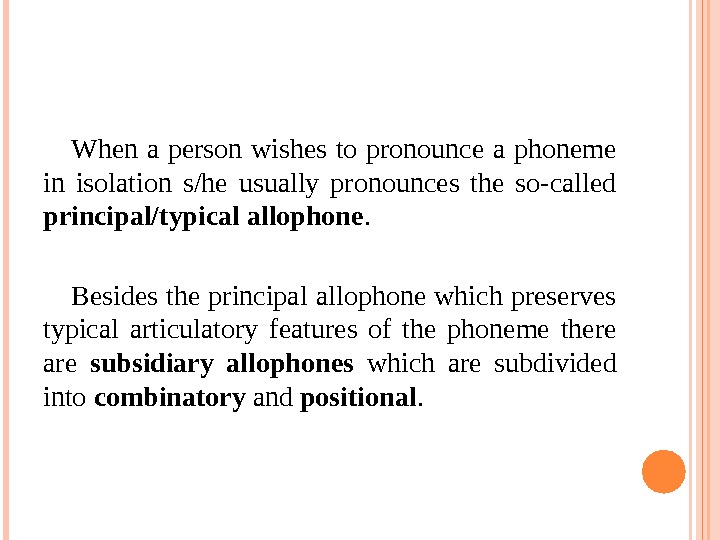
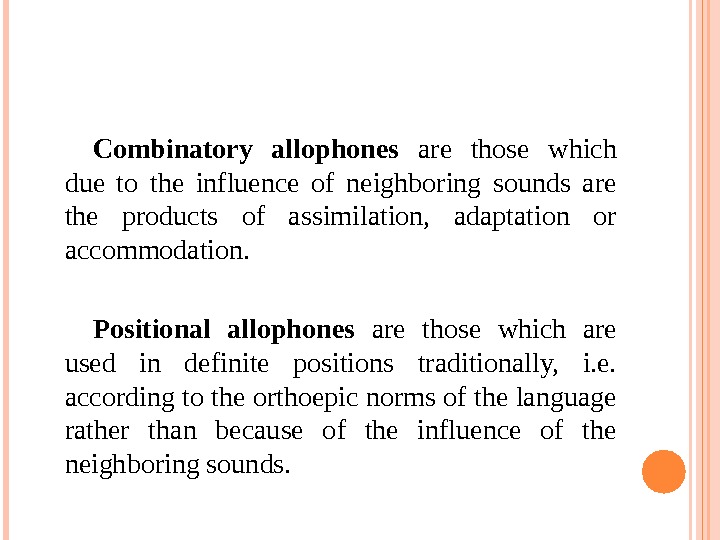
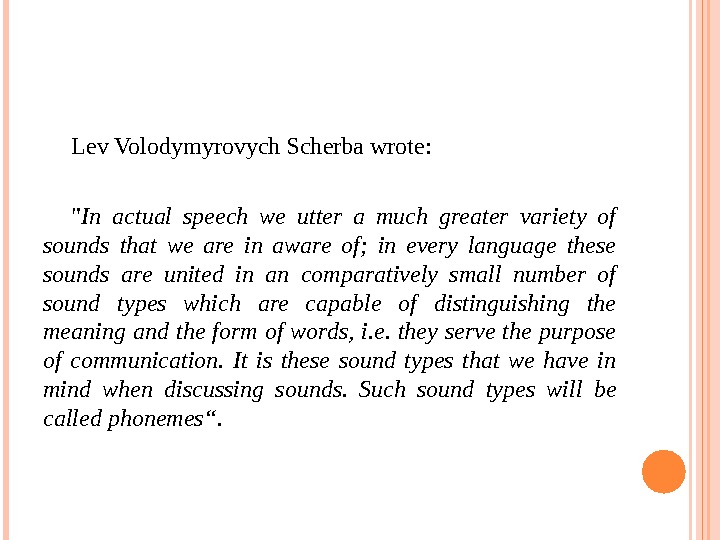
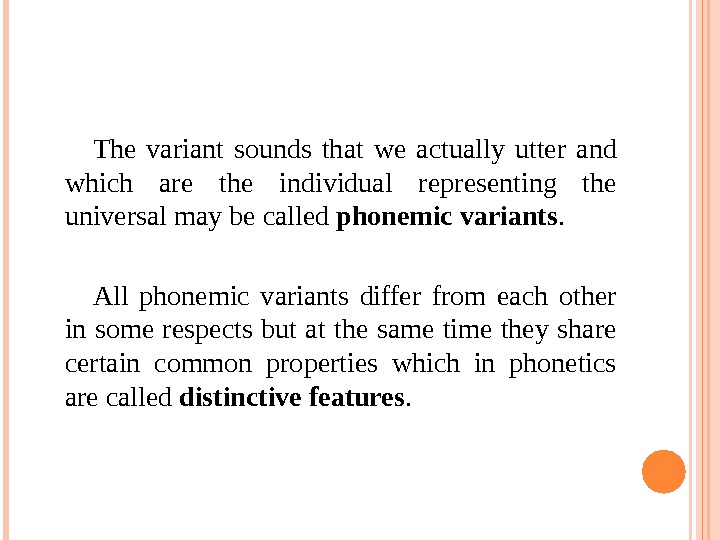
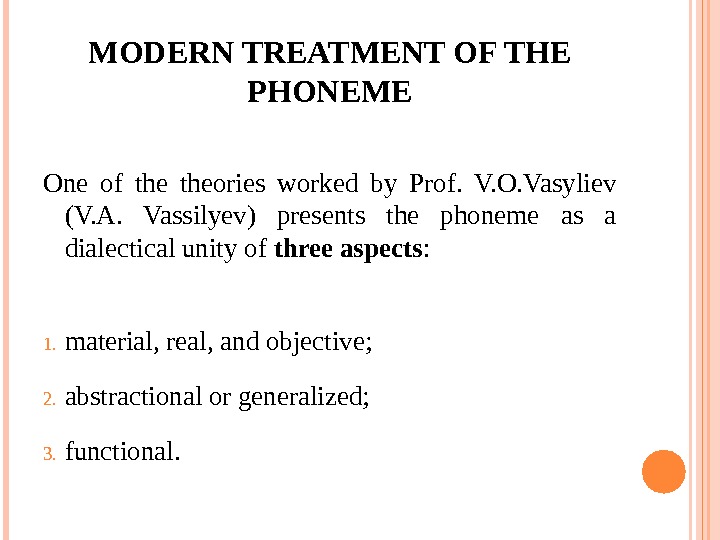
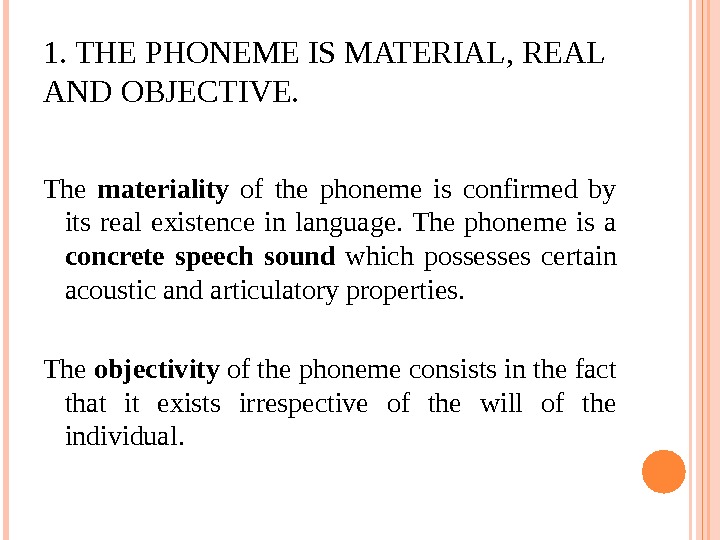
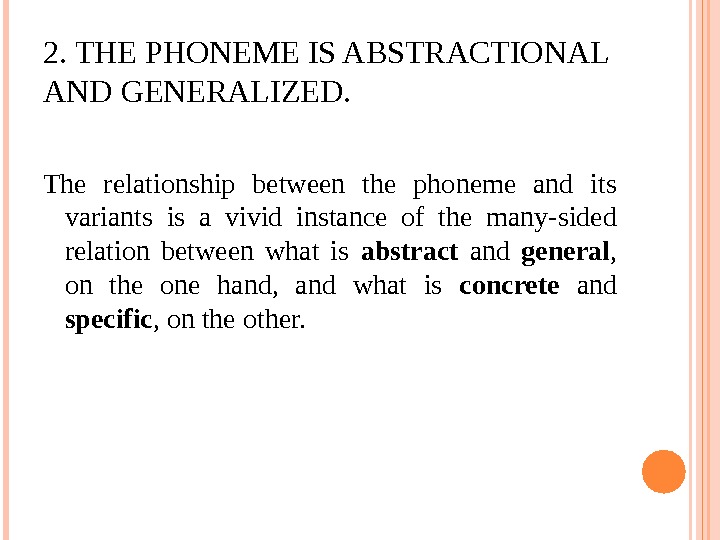
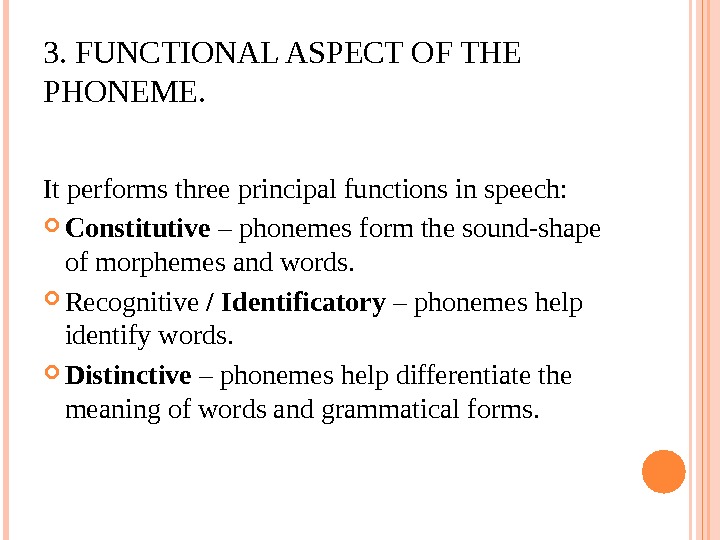
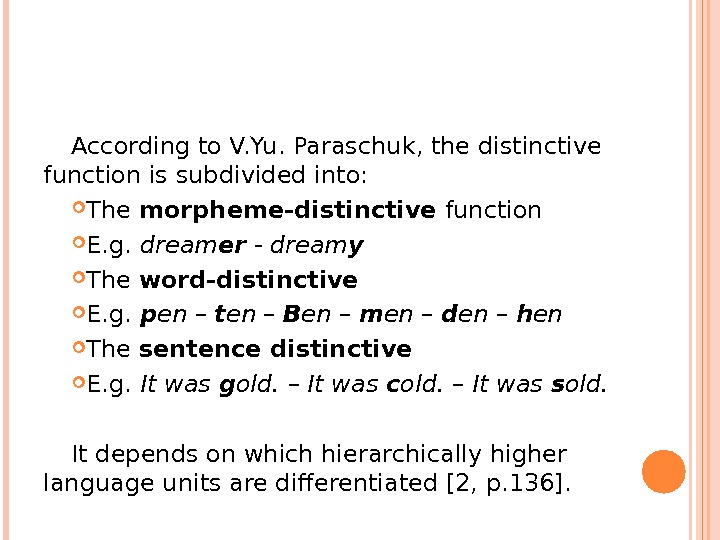
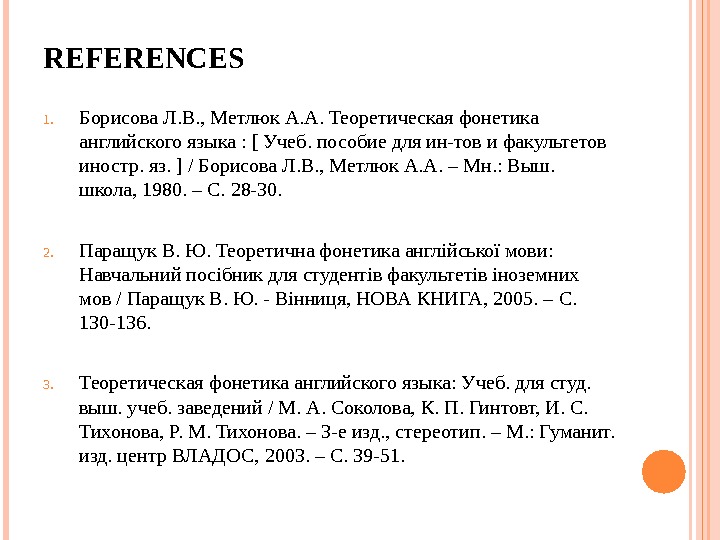
english_phonetics_lecture_2.ppt
- Размер: 622 Кб
- Количество слайдов: 27
Описание презентации LECTURE 2. PHONEMES AND THEIR VARIANTS (ALLOPHONES) Points по слайдам
 LECTURE 2. PHONEMES AND THEIR VARIANTS (ALLOPHONES) Points for Discussion: • The Notion of the Phoneme • The Relationship between the Phoneme and Its Allophones • The Aspects of the Phoneme • The Functions of the Phoneme
LECTURE 2. PHONEMES AND THEIR VARIANTS (ALLOPHONES) Points for Discussion: • The Notion of the Phoneme • The Relationship between the Phoneme and Its Allophones • The Aspects of the Phoneme • The Functions of the Phoneme
 The human speaking apparatus is capable of articulating a great number of various sounds. Some of the differences exist as physical facts and are not always linguistic facts. Cf. : p eak – s p eak aspiration – no aspiration
The human speaking apparatus is capable of articulating a great number of various sounds. Some of the differences exist as physical facts and are not always linguistic facts. Cf. : p eak – s p eak aspiration – no aspiration
 The only important things for language are those which can be associated with meaning and be used for the purposes of communication. We can differentiate and distinguish, recognize the shapes of words only when opposing one sound shape to another or even to many of them.
The only important things for language are those which can be associated with meaning and be used for the purposes of communication. We can differentiate and distinguish, recognize the shapes of words only when opposing one sound shape to another or even to many of them.
 The opposition of different sound shapes is the basis of understanding. E. g. bead [bi d] ː bed [bed] bid [b d] ɪ bad [bæd] board [b d] ɔː bard [b d]ɑː bird [b d] ɜː bud [b d]ʌ Opposing the vowels [i ], [e], [æ], [ ], ː ɪ ɔː ɑː ɜː [ ] ʌ we can see that they are used as independent units for the purposes of word differentiation. The consonants [n] – [f], [t] – [d], [p] – [t] are opposed in the following pairs of words line – life, try – dry, pen – ten.
The opposition of different sound shapes is the basis of understanding. E. g. bead [bi d] ː bed [bed] bid [b d] ɪ bad [bæd] board [b d] ɔː bard [b d]ɑː bird [b d] ɜː bud [b d]ʌ Opposing the vowels [i ], [e], [æ], [ ], ː ɪ ɔː ɑː ɜː [ ] ʌ we can see that they are used as independent units for the purposes of word differentiation. The consonants [n] – [f], [t] – [d], [p] – [t] are opposed in the following pairs of words line – life, try – dry, pen – ten.
 There exist speech sounds which are the basis for the differentiation of the sound shapes of words and grammatical forms of one and the same word. We call such sounds phonemes.
There exist speech sounds which are the basis for the differentiation of the sound shapes of words and grammatical forms of one and the same word. We call such sounds phonemes.
 According to professor V. O. Vasyliev (V. A. Vassilyev), the segmental phoneme is the smallest (i. e. further indivisible into smaller consecutive segments) language unit (sound type) that exists in the speech of all the members of a given community as such speech sounds which are capable of distinguishing one word from another word of the same language or one grammatical form of a word from another grammatical form of the same word [2, p. 131].
According to professor V. O. Vasyliev (V. A. Vassilyev), the segmental phoneme is the smallest (i. e. further indivisible into smaller consecutive segments) language unit (sound type) that exists in the speech of all the members of a given community as such speech sounds which are capable of distinguishing one word from another word of the same language or one grammatical form of a word from another grammatical form of the same word [2, p. 131].
 M. O. Sokolova et al. give a more concise definition: The phoneme is a minimal abstract linguistic unit realized in speech in the form of speech sounds opposable to other phonemes of the same language to distinguish the meaning of morphemes and words [3, p. 40].
M. O. Sokolova et al. give a more concise definition: The phoneme is a minimal abstract linguistic unit realized in speech in the form of speech sounds opposable to other phonemes of the same language to distinguish the meaning of morphemes and words [3, p. 40].
 Ivan Oleksandrovych (Jan Niecisław) Baudouin de Courtenay used the term ‘phoneme’ and developed it into the phoneme theory. During the first stage of the development of his phoneme theory he views the phoneme as a component of the morpheme and tries to analyze phonemes according to their function in the morphemes.
Ivan Oleksandrovych (Jan Niecisław) Baudouin de Courtenay used the term ‘phoneme’ and developed it into the phoneme theory. During the first stage of the development of his phoneme theory he views the phoneme as a component of the morpheme and tries to analyze phonemes according to their function in the morphemes.
 In 1890 s the psychological approach in linguistics began to prevail, and the scientist abandoned his morphological conception and tried to find a unit which would not be bound by the limits of the morpheme. He began to consider the phoneme as a general idea of a sound which arises in a person’s mind before s/he utters a sound.
In 1890 s the psychological approach in linguistics began to prevail, and the scientist abandoned his morphological conception and tried to find a unit which would not be bound by the limits of the morpheme. He began to consider the phoneme as a general idea of a sound which arises in a person’s mind before s/he utters a sound.
 Lev Volodymyrovych Scherba was the first to suggest the idea of the sense-differentiating function of the phoneme. Moreover, he attached considerable importance to phonemic variants , or allophones , and stressed that one of the main reasons why variants are important is that they represent phonemes in actual speech.
Lev Volodymyrovych Scherba was the first to suggest the idea of the sense-differentiating function of the phoneme. Moreover, he attached considerable importance to phonemic variants , or allophones , and stressed that one of the main reasons why variants are important is that they represent phonemes in actual speech.
 Any phoneme only exists in the form of actually pronounced speech sounds which are its variants. In the course of research work it was discovered that the representatives of any linguistic community utter much more sounds in comparison with the number of phonemes.
Any phoneme only exists in the form of actually pronounced speech sounds which are its variants. In the course of research work it was discovered that the representatives of any linguistic community utter much more sounds in comparison with the number of phonemes.
![[leɪ t ] [ t en] [ t raɪ] [ˈbæ tə l] [ t uː] [leɪ t ] [ t en] [ t raɪ] [ˈbæ tə l] [ t uː]](/docs//english_phonetics_lecture_2_images/english_phonetics_lecture_2_11.jpg) [leɪ t ] [ t en] [ t raɪ] [ˈbæ tə l] [ t uː]
[leɪ t ] [ t en] [ t raɪ] [ˈbæ tə l] [ t uː]
![Each word contains the sound [t]. Each of these [t]-sounds has its neighboring sounds and Each word contains the sound [t]. Each of these [t]-sounds has its neighboring sounds and](/docs//english_phonetics_lecture_2_images/english_phonetics_lecture_2_12.jpg) Each word contains the sound [t]. Each of these [t]-sounds has its neighboring sounds and positions in the word. Due to these factors each of them has its own peculiarities of articulation.
Each word contains the sound [t]. Each of these [t]-sounds has its neighboring sounds and positions in the word. Due to these factors each of them has its own peculiarities of articulation.
![In the word [le t] ɪ the sound [t] is in the final position and In the word [le t] ɪ the sound [t] is in the final position and](/docs//english_phonetics_lecture_2_images/english_phonetics_lecture_2_13.jpg) In the word [le t] ɪ the sound [t] is in the final position and undergoes the least possible influence from the neighboring phonemes. Thus, it is the nearest to the cardinal phoneme [t]. In [ten] the sound [t] is in the initial position before the front vowel [e], so it is slightly palatalized under its influence.
In the word [le t] ɪ the sound [t] is in the final position and undergoes the least possible influence from the neighboring phonemes. Thus, it is the nearest to the cardinal phoneme [t]. In [ten] the sound [t] is in the initial position before the front vowel [e], so it is slightly palatalized under its influence.
![In the word [tra ] ɪ the sound [t] stands before the postalveolar forelingual phoneme In the word [tra ] ɪ the sound [t] stands before the postalveolar forelingual phoneme](/docs//english_phonetics_lecture_2_images/english_phonetics_lecture_2_14.jpg) In the word [tra ] ɪ the sound [t] stands before the postalveolar forelingual phoneme [r] and under its influence it becomes postalveolar as well. In the word [ bæt ˈə l] plosive [t] becomes lateral under the influence of the lateral sonorant [l]. In the word [tu ] ː the phoneme becomes labialized under the influence of the labial [u ]. ː
In the word [tra ] ɪ the sound [t] stands before the postalveolar forelingual phoneme [r] and under its influence it becomes postalveolar as well. In the word [ bæt ˈə l] plosive [t] becomes lateral under the influence of the lateral sonorant [l]. In the word [tu ] ː the phoneme becomes labialized under the influence of the labial [u ]. ː
![From the acoustic point of view each of these [t]-sounds has its peculiarities and slightly From the acoustic point of view each of these [t]-sounds has its peculiarities and slightly](/docs//english_phonetics_lecture_2_images/english_phonetics_lecture_2_15.jpg) From the acoustic point of view each of these [t]-sounds has its peculiarities and slightly differs from others. Each of them is articulate in its own way but from the point of view of p hon ology we perceive all these [t]-sounds as one and the same [t]-phoneme because they do not change the meaning of words to the degree of quite new ones.
From the acoustic point of view each of these [t]-sounds has its peculiarities and slightly differs from others. Each of them is articulate in its own way but from the point of view of p hon ology we perceive all these [t]-sounds as one and the same [t]-phoneme because they do not change the meaning of words to the degree of quite new ones.
 According to L. V. Borysova , allophones [from the Greek: λλος, állos, «other» and φωνή, phōnē, ἄ «voice, sound“] (or variants) of a certain phoneme are speech sounds which are realizations of one and the same phoneme and which, therefore, cannot distinguish words. Allophones of a phoneme which never occur in identical positions are said to be in complementary distribution [1, pp. 28 -29].
According to L. V. Borysova , allophones [from the Greek: λλος, állos, «other» and φωνή, phōnē, ἄ «voice, sound“] (or variants) of a certain phoneme are speech sounds which are realizations of one and the same phoneme and which, therefore, cannot distinguish words. Allophones of a phoneme which never occur in identical positions are said to be in complementary distribution [1, pp. 28 -29].
 When a person wishes to pronounce a phoneme in isolation s/he usually pronounces the so-called principal/typical allophone. Besides the principal allophone which preserves typical articulatory features of the phoneme there are subsidiary allophones which are subdivided into combinatory and positional.
When a person wishes to pronounce a phoneme in isolation s/he usually pronounces the so-called principal/typical allophone. Besides the principal allophone which preserves typical articulatory features of the phoneme there are subsidiary allophones which are subdivided into combinatory and positional.
 Combinatory allophones are those which due to the influence of neighboring sounds are the products of assimilation, adaptation or accommodation. Positional allophones are those which are used in definite positions traditionally, i. e. according to the orthoepic norms of the language rather than because of the influence of the neighboring sounds.
Combinatory allophones are those which due to the influence of neighboring sounds are the products of assimilation, adaptation or accommodation. Positional allophones are those which are used in definite positions traditionally, i. e. according to the orthoepic norms of the language rather than because of the influence of the neighboring sounds.
 Lev Volodymyrovych Scherba wrote: » In actual speech we utter a much greater variety of sounds that we are in aware of; in every language these sounds are united in an comparatively small number of sound types which are capable of distinguishing the meaning and the form of words, i. e. they serve the purpose of communication. It is these sound types that we have in mind when discussing sounds. Such sound types will be called phonemes“.
Lev Volodymyrovych Scherba wrote: » In actual speech we utter a much greater variety of sounds that we are in aware of; in every language these sounds are united in an comparatively small number of sound types which are capable of distinguishing the meaning and the form of words, i. e. they serve the purpose of communication. It is these sound types that we have in mind when discussing sounds. Such sound types will be called phonemes“.
 The variant sounds that we actually utter and which are the individual representing the universal may be called phonemic variants. All phonemic variants differ from each other in some respects but at the same time they share certain common properties which in phonetics are called distinctive features.
The variant sounds that we actually utter and which are the individual representing the universal may be called phonemic variants. All phonemic variants differ from each other in some respects but at the same time they share certain common properties which in phonetics are called distinctive features.
 MODERN TREATMENT OF THE PHONEME One of theories worked by Prof. V. O. Vasyliev (V. A. Vassilyev) presents the phoneme as a dialectical unity of three aspects : 1. material, real, and objective; 2. abstractional or generalized; 3. functional.
MODERN TREATMENT OF THE PHONEME One of theories worked by Prof. V. O. Vasyliev (V. A. Vassilyev) presents the phoneme as a dialectical unity of three aspects : 1. material, real, and objective; 2. abstractional or generalized; 3. functional.
 1. THE PHONEME IS MATERIAL, REAL AND OBJECTIVE. The materiality of the phoneme is confirmed by its real existence in language. The phoneme is a concrete speech sound which possesses certain acoustic and articulatory properties. The objectivity of the phoneme consists in the fact that it exists irrespective of the will of the individual.
1. THE PHONEME IS MATERIAL, REAL AND OBJECTIVE. The materiality of the phoneme is confirmed by its real existence in language. The phoneme is a concrete speech sound which possesses certain acoustic and articulatory properties. The objectivity of the phoneme consists in the fact that it exists irrespective of the will of the individual.
 2. THE PHONEME IS ABSTRACTIONAL AND GENERALIZED. The relationship between the phoneme and its variants is a vivid instance of the many-sided relation between what is abstract and general , on the one hand, and what is concrete and specific , on the other.
2. THE PHONEME IS ABSTRACTIONAL AND GENERALIZED. The relationship between the phoneme and its variants is a vivid instance of the many-sided relation between what is abstract and general , on the one hand, and what is concrete and specific , on the other.
 3. FUNCTIONAL ASPECT OF THE PHONEME. It performs three principal functions in speech: Constitutive – phonemes form the sound-shape of morphemes and words. Recognitive / Identificatory – phonemes help identify words. Distinctive – phonemes help differentiate the meaning of words and grammatical forms.
3. FUNCTIONAL ASPECT OF THE PHONEME. It performs three principal functions in speech: Constitutive – phonemes form the sound-shape of morphemes and words. Recognitive / Identificatory – phonemes help identify words. Distinctive – phonemes help differentiate the meaning of words and grammatical forms.
 According to V. Yu. Paraschuk, the distinctive function is subdivided into: The morpheme-distinctive function E. g. dream er — dream y The word-distinctive E. g. p en – t en – B en – m en – d en – h en The sentence distinctive E. g. It was g old. – It was c old. – It was s old. It depends on which hierarchically higher language units are differentiated [2, p. 136].
According to V. Yu. Paraschuk, the distinctive function is subdivided into: The morpheme-distinctive function E. g. dream er — dream y The word-distinctive E. g. p en – t en – B en – m en – d en – h en The sentence distinctive E. g. It was g old. – It was c old. – It was s old. It depends on which hierarchically higher language units are differentiated [2, p. 136].
 REFERENCES 1. Борисова Л. В. , Метлюк А. А. Теоретическая фонетика английского языка : [ Учеб. пособие для ин-тов и факультетов иностр. яз. ] / Борисова Л. В. , Метлюк А. А. – Мн. : Выш. школа, 1980. – C. 28 -30. 2. Паращук В. Ю. Тео ретич на фонетика англійської мови: Навчальний посібник для студентів факультетів іноземних мов / Паращук В. Ю. — Вінниця, НОВА КНИГА, 2005. – C. 130 -136. 3. Теоретическая фонетика английского языка: Учеб. для студ. выш. учеб. заведений / М. А. Соколова, К. П. Гинтовт, И. С. Тихонова, Р. М. Тихонова. – 3 -е изд. , стереотип. – М. : Гуманит. изд. центр ВЛАДОС, 2003. – C. 39 -51.
REFERENCES 1. Борисова Л. В. , Метлюк А. А. Теоретическая фонетика английского языка : [ Учеб. пособие для ин-тов и факультетов иностр. яз. ] / Борисова Л. В. , Метлюк А. А. – Мн. : Выш. школа, 1980. – C. 28 -30. 2. Паращук В. Ю. Тео ретич на фонетика англійської мови: Навчальний посібник для студентів факультетів іноземних мов / Паращук В. Ю. — Вінниця, НОВА КНИГА, 2005. – C. 130 -136. 3. Теоретическая фонетика английского языка: Учеб. для студ. выш. учеб. заведений / М. А. Соколова, К. П. Гинтовт, И. С. Тихонова, Р. М. Тихонова. – 3 -е изд. , стереотип. – М. : Гуманит. изд. центр ВЛАДОС, 2003. – C. 39 -51.
